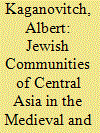|
|
|
Sort Order |
|
|
|
Items / Page
|
|
|
|
|
|
|
| Srl | Item |
| 1 |
ID:
102708


|
|
|
|
|
| Publication |
2011.
|
| Summary/Abstract |
This paper is based on an earlier one about James Baillie Fraser's trip to Khorasan in the 1820s, the first European to travel there in the Qajar era. But instead of focusing on Fraser's experience, the information given by him is used to view the circumstances in Khorasan from an Iranian perspective, which, in turn, is derived from a study of the three main categories of people met by Fraser. Through them and their careers, the paper analyzes the problems, both inherited and new, that the early Qajars faced from the outset. Each of the three categories is dealt with separately under the headings of Prince-Governors, Princes in Exile or in Obeisance and, finally, High Priests. Together these complete the overall picture in Greater Khorasan and, by extension, throughout Iran at that particular time. What emerges from a study of their careers are the seeds of some of the major trends that were to mark nineteenth-century Iran. Khorasan, with its size and position, was particularly well placed to afford a view of a society still dependent on tribal vagaries and the dominant role of the religious hierarchy. Above all, the geo-strategic location of the province affords a privileged view across to the outlying parts of Greater Khorasan which, although still viewed from inside as a part of Greater Iran, were, due to inherent instabilities, liable to manipulation by British and Russian imperialism. The most effective tool of the latter was a propensity to promote new national entities on the ruins of an empire struggling to sustain itself without means and with a dated mindset of which most people were sorely unaware. By projecting the circumstances of time and place onto the future, one can perceive a certain degree of inevitability in the upcoming history of Qajar Iran.
|
|
|
|
|
|
|
|
|
|
|
|
|
|
|
|
| 2 |
ID:
168992


|
|
|
|
|
| Summary/Abstract |
When the Jews first settled in Central Asia is uncertain, but circumstantial evidence clearly indicates that this happened at least two and a half thousand years ago. In the first millennium AD, the Jews lived only in cities no farther than 750 km east of the Caspian sea (in the eighth–eleventh centuries the sea was called Khazarian). Only later did they migrate to the central part of the region, to cities like Samarkand and Bukhara. It is possible that Jews from Khazaria joined them, since they already had tight trade connections with Central Asia and China. There is no trace of evidence regarding the existence of Jews in the entirety of Central Asia in the early sixteenth century. At the very end of the sixteenth century Bukhara became the new ethnoreligious center of the Jews in that region. In the first half of the nineteenth century, thanks to European travelers visiting Central Asia at that time, the term “Bukharan Jews” was assigned to this sub-ethnic Jewish group. Drawing on a wide range of primary and secondary source materials, this article aims to prove that the presence of Jews in Central Asia was not continuous, and therefore the modern Bukharan Jews are not descendants of the first Jewish settlers there. It also attempts to determine where Central Asia’s first Jewish population disappeared to.
|
|
|
|
|
|
|
|
|
|
|
|
|
|
|
|
|
|
|
|
|